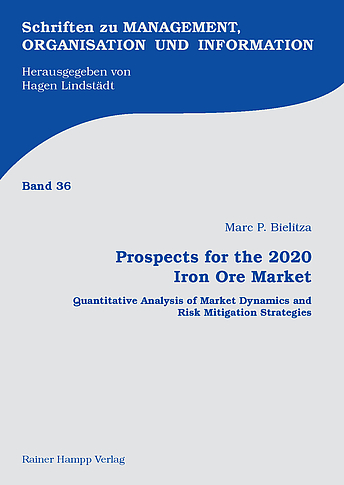Bielitza
Prospects for the 2020 Iron Ore Market
ISBN 978-3-86618-679-8
englischAs the key ingredient for steelmaking, iron ore is integral to the global economy and represents the world's second-largest natural resource market by value. The overall structure and dynamics of the iron ore market have recently undergone various radical changes. The global demand shock caused by the rapid industrialization of China has sent market prices skywards and triggered a collapse of the 40-year-old benchmark pricing system. The newly adopted quarterly index-based pricing mechanism has brought an abrupt end to the traditional stability of the iron ore market, with price dynamics now experiencing greater volatility. Against the backdrop of these disruptive changes, this dissertation proposes a deterministic nine-region spatial equilibrium model of the 2020 iron ore market based on the fundamental characteristics and mechanics of the market. Key features of the model are its bottom-up structure, modeling supply volumes and costs on an individual mine level as well as the simulation of interregional trade flows using a linear optimization approach. In analyzing a number of relevant scenarios, this dissertation projects the key characteristics of the 2020 global iron ore market in terms of regional production volumes, demand, iron ore trade flows and market prices. It quantifies market dynamics based on changes in available production capacity, demand and freight rates. From a demand perspective, the dissertation proposes several strategies to mitigate the risk arising from higher and more volatile iron ore prices. Of these strategies, the captivity of mines and the introduction of iron ore export taxes are analyzed in greater detail with respect to their effectiveness and influence on the iron ore market.
As the key ingredient for steelmaking, iron ore is integral to the global economy and represents the world's second-largest natural resource market by value. The overall structure and dynamics of the iron ore market have recently undergone various radical changes. The global demand shock caused by the rapid industrialization of China has sent market prices skywards and triggered a collapse of the 40-year-old benchmark pricing system. The newly adopted quarterly index-based pricing mechanism has brought an abrupt end to the traditional stability of the iron ore market, with price dynamics now experiencing greater volatility. Against the backdrop of these disruptive changes, this dissertation proposes a deterministic nine-region spatial equilibrium model of the 2020 iron ore market based on the fundamental characteristics and mechanics of the market. Key features of the model are its bottom-up structure, modeling supply volumes and costs on an individual mine level as well as the simulation of interregional trade flows using a linear optimization approach. In analyzing a number of relevant scenarios, this dissertation projects the key characteristics of the 2020 global iron ore market in terms of regional production volumes, demand, iron ore trade flows and market prices. It quantifies market dynamics based on changes in available production capacity, demand and freight rates. From a demand perspective, the dissertation proposes several strategies to mitigate the risk arising from higher and more volatile iron ore prices. Of these strategies, the captivity of mines and the introduction of iron ore export taxes are analyzed in greater detail with respect to their effectiveness and influence on the iron ore market.


